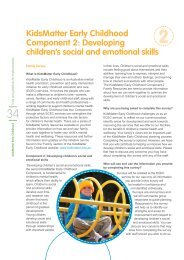KidsMatter Early Childhood Component 1 Literature Review
KidsMatter Early Childhood Component 1 Literature Review
KidsMatter Early Childhood Component 1 Literature Review
You also want an ePaper? Increase the reach of your titles
YUMPU automatically turns print PDFs into web optimized ePapers that Google loves.
<strong>Literature</strong> <strong>Review</strong><strong>Component</strong> 1: Creating a sense ofcommunity
R 22 Gesundheitsschädlich beim VerschluckenS-Sätze:S 2 Nicht in die Hände von Kindern gelangen lassen· 2.3 Sonstige Gefahren-3. ZUSAMMENSETZUNG/ANGABEN ZU BESTANDTEILEN· 3.1 Chemische Charakterisierung (Stoff)· 3.2 Chemische Charakterisierung (Gemisch)Beschreibung:Wässrige TiO2-haltige Suspension mit EthylenglycolGefährliche Inhaltsstoffe: EthylenglykolEinstufung nach DSD -DPDStoffbezeichnung ID Nummern % Einstufung Gefahrenhinweise(R)Titandioxid CAS.EINECS.INDEX:REACHColor Ind..13463-67-7236-675-5-01-2119489379-17-0005C.I. 77891 Pigment white 6ca. 20 - -EthylenglykolCAS.EINECS.INDEX:REACHEinstufung nach CLP107-21-1203-473-3603-027-00-101-2119456816-28-xxxx40 - 50 Xn 22Stoffbezeichnung ID Nummern % Einstufung Gefahrenhinweise(H)Titandioxid CAS.EINECS.INDEX:REACHColor Ind..13463-67-7236-675-5-01-2119489379-17-0005C.I. 77891 Pigment white 6ca. 20 - -EthylenglykolCAS.EINECS.INDEX:REACH107-21-1203-473-3603-027-00-101-2119456816-28-xxxx40 - 50 Akute Toxizität,Kat. 43024. ERSTE-HILFE-MAßNAHMEN· 4.1 Beschreibung der Erste-Hilfe-MaßnahmenAllgemeine Hinweise: -Einatmen:Frischluft. Atemwege freihalten.Hautkontakt:Mit reichlich Wasser abwaschen. Kontaminierte Kleidungentfernen.Augenkontakt:Mit reichlich Wasser bei geöffnetem Lidspalt ausspülen. Ggf.Augenarzt hinzuziehen.Verschlucken:Sofort Wasser trinken lassen (maximal 2 Trinkgläser). Nachgabevon:Aktivkohle (20 - 40 g in 10 %iger Aufschwemmung). Arztkonsultieren.· 4.2 Wichtigste akute und verzögert auftretende Symptome und WirkungenSeite: 2/7
<strong>KidsMatter</strong> <strong>Early</strong> <strong>Childhood</strong> <strong>Component</strong> 1 <strong>Literature</strong> <strong>Review</strong> 3Contents<strong>Component</strong> 1: Creating a sense of community 5Background Information on <strong>KidsMatter</strong> <strong>Early</strong> <strong>Childhood</strong> ....................................................................... 5Creating a sense of community 7Belonging and connectedness .................................................................................................................. 7Inclusion ....................................................................................................................................................... 8Positive relationships .................................................................................................................................. 9Collaboration .............................................................................................................................................. 12Summary and Implications for Practice .................................................................................................. 15References 16www.kidsmatter.edu.au
<strong>KidsMatter</strong> <strong>Early</strong> <strong>Childhood</strong> <strong>Component</strong> 1 <strong>Literature</strong> <strong>Review</strong> 4www.kidsmatter.edu.au
<strong>KidsMatter</strong> <strong>Early</strong> <strong>Childhood</strong> <strong>Component</strong> 1 <strong>Literature</strong> <strong>Review</strong> 5<strong>Component</strong> 1: Creating a sense ofcommunityBackground Information on <strong>KidsMatter</strong> <strong>Early</strong> <strong>Childhood</strong><strong>KidsMatter</strong> <strong>Early</strong> <strong>Childhood</strong> is a national mental health promotion, prevention and earlyintervention initiative developed to support the mental health and wellbeing of youngchildren in early childhood education and care services (ECEC). It has been developed incollaboration with beyondblue, the Australian Psychological Society and <strong>Early</strong> <strong>Childhood</strong>Australia, with funding from the Australian Government Department of Health and Ageingand beyondblue. It involves families, early childhood professionals, and a range ofcommunity and health professionals working together to make a positive difference toyoung children’s mental health and wellbeing during this important developmental periodof birth to five years.<strong>KidsMatter</strong> <strong>Early</strong> <strong>Childhood</strong> uses a risk and protective factor framework to focus on fourcomponents that ECEC services can use to strengthen the protective factors and minimiserisk factors for children’s mental health and wellbeing.All four components are outlined below.1. CREATING A SENSE OFCOMMUNITY within ECEC servicesby focusing on belonging, inclusion,positive relationships andcollaboration.2. DEVELOPING CHILDREN’S SOCIALAND EMOTIONAL SKILLS isfundamental to children’s mentalhealth. These skills are developedthrough adults’ warm, responsive andtrusting relationships with the childrenin their care, as well as throughconstructive peer relationships.www.kidsmatter.edu.au
<strong>KidsMatter</strong> <strong>Early</strong> <strong>Childhood</strong> <strong>Component</strong> 1 <strong>Literature</strong> <strong>Review</strong> 63. WORKING WITH PARENTS AND CARERS ECEC services and families canestablish collaborative partnerships in the interests of their children. ECEC servicescan support families by helping them to connect with other families and by providingaccess to parenting support.4. HELPING CHILDREN WHO ARE EXPERIENCING MENTAL HEALTHDIFFICULTIES. ECEC services are well placed to recognise when young childrenmay be experiencing difficulties, to implement simple strategies to assist children,and to support families to seek additional help.Definitions of terms used in this documentChildren: Children from birth to five years unless otherwise stated.Culturally and Linguistically Diverse (CALD): A broad concept that encompasses individual differences,such as language, dress, traditions, food, societal structures, art and religion.<strong>Early</strong> childhood education and care (ECEC) services: Preschools, kindergartens and long day careservices.<strong>Early</strong> childhood staff: Educators, teachers, day care staff, integration aides, assistants, and other staff thatare based within ECEC services.Externalising: Disruptive, impulsive, angry or hyperactive behaviours (i.e. where the child ‘acts out’). Thesebehaviours are generally readily observed and therefore are relatively easy to detect.Internalising: Inhibited or over-controlled behaviours (i.e. where the child ‘holds in’ their difficulties),including withdrawal, worry, and emotional responses that primarily affect the individual child rather thanhaving effects on others.Mental health: <strong>Early</strong> childhood mental health involves being able to experience, manage and expressemotions; form close, satisfying relationships; and explore and discover the environment.Parents and carers: This includes biological mothers and fathers, parents of adopted children, GLBTparents, foster parents, grandparents, aunties and uncles. The primary caregivers of a child/children and areusually the child’s legal guardians.Protective factors: Strengths that enable children to maintain positive mental health and wellbeing, eventhough risk factors for mental health problems are present.Resilience: A person’s capacity to adapt to adverse situations in ways that enable them to cope positivelyand reduce or minimise negative impacts on mental health and wellbeing.Risk factors: Factors that increase the likelihood that mental health difficulties will develop. The presence ofparticular risk factors does not necessarily mean a difficulty will develop. The presence of multiple riskfactors usually increases the likelihood of difficulties developing.Temperament: Individual characteristics and style of behaviour that a child is born with, now considered tohave a basis in both biology and environment.www.kidsmatter.edu.au
<strong>KidsMatter</strong> <strong>Early</strong> <strong>Childhood</strong> <strong>Component</strong> 1 <strong>Literature</strong> <strong>Review</strong> 7Creating a sense of communityEARLY CHILDHOOD EDUCATION AND CARE SERVICES CAN PLAY ANIMPORTANT ROLE IN CREATING A SENSE OF COMMUNITY.<strong>Component</strong> 1 of the <strong>KidsMatter</strong> <strong>Early</strong> <strong>Childhood</strong> initiative: Creating a sense of communityfocuses on four target areas selected because of their impact on children’s mental healthand wellbeing: belonging and connectedness; inclusion; positive relationships; andcollaboration. While there is some overlap in the target areas, each also makes a uniquecontribution to building a positive sense of community in an early childhood service. Eachof the target areas is discussed in detail below. The numbers appearing in the text arelinked to references listed at the end of the document. If you would like more informationabout the ideas presented in this paper, the reference list is a starting point.Belonging and connectednessCULTIVATING BELONGING AND CONNECTEDNESS is an important part of buildinga positive community at an early childhood service. Belonging comes from feelingvalued, accepted, respected and cared about by others. The sense of belonging to acommunity is a two way process of contributing to and receiving the benefit of others’friendship and care. 1-3A sense of belonging isfundamental to life. Peopleseek out meaningful, lastingrelationships in order tomeet their need to belong. 4To foster a sense of belonging,these interactions need to beenjoyable, frequent, andinvolve mutual, genuine regardfor each other’s wellbeing. Inaddition, continuity ofrelationships is an importantfactor in enhancing a sense of belonging and connectedness. 4During the early years, a sense of belonging and connectedness facilitates manyprotective factors for good mental health and wellbeing. 3,5 These include a positivesense of self; strong relationships with others; and, perhaps most importantly, a strongsense of identity. 3,6 Belonging has been described as the relational part of identity, or the‘glue’ that connects one individual to others; to places (e.g., home and ECEC services);www.kidsmatter.edu.au
<strong>KidsMatter</strong> <strong>Early</strong> <strong>Childhood</strong> <strong>Component</strong> 1 <strong>Literature</strong> <strong>Review</strong> 8and to beliefs and ideas (e.g., cultural or religious practices). 3 All children grow anddevelop in the context of these connections. 6Children who experience a positive sense of community in an early childhoodservice are more likely to feel connected and that they belong. 3,6 They are also morelikely to be involved in their community in positive ways and to benefit from belonging toit. 3,6 In contrast, children who feel they don’t belong or feel disconnected from theircommunity through experiences such as exclusion, discrimination and lack of involvement,are at greater risk of experiencing isolation, loneliness and developing mental healthdifficulties (such as anxiety, depression or low self-esteem) in childhood and beyond. 3,4,6Children who are connectedand feel that they belong inthe worlds they inhabit aremore likely to develop astrong identity, a positivesense of self and strongrelationships with others.ECEC services can make a positive differenceto children’s mental health and wellbeing bycreating an environment that fosters belongingand connectedness. Belonging andconnectedness are enhanced when ECECservices are welcoming and inclusive, and thereare clear and accessible opportunities for everyoneto contribute and get involved. 7InclusionINCLUSION is about respecting diversity. 8 Australia is known for being one of the mostculturally diverse societies in the world. In its broadest sense, diversity is about“understanding and appreciating different ways of thinking and being” 9(p1)Respecting diversity can relate to cultural (e.g., children from CALD backgrounds), family(e.g., single parent or same sex parents) and individual differences (e.g., gender, age,abilities, interests). Valuing every child’s own individuality and unique qualities is anessential part of respecting diversity. 9,10 Truly inclusive practise in an early childhoodsetting involves actively finding ways to respect these differences and to value each childfor their individual qualities. 11Making inclusion and respect for diversity a priority is particularly important inan early childhood setting. Children are less likely to hold negative attitudestowards differences and to exclude other children because of individualdifferences.When inclusion is made a priority at an early childhood service, the benefits tomental health and wellbeing are numerous and wide-reaching. 12,13 For example, whenwww.kidsmatter.edu.au
<strong>KidsMatter</strong> <strong>Early</strong> <strong>Childhood</strong> <strong>Component</strong> 1 <strong>Literature</strong> <strong>Review</strong> 9a child feels their family, community background and individual uniqueness are respectedand valued, their sense of identity, belonging and self-esteem is reinforced. 9 Furthermore,children who feel included at the service they attend are better able to participate activelyin collective and social activities, form strong relationships with significant others and enjoythe benefits associated with being a part of the early childhood community. 9During early childhood children first become aware of differences among peopleand start to form opinions and attitudes about those differences. It also a time whenchildren are highly influenced by the values, attitudes and behaviour of respectedadults. As such, promoting inclusion and respect for diversity is of utmostimportance for ECEC services during this time. 12,14 Children who attend a service thatmakes inclusion and respect for diversity a priority are less likely to hold negative attitudestowards these differences and to exclude other children because of them. 13 Children’sattitudes about, and responses to, diversity amongst their peers can be shaped andguided by those around them. Inclusion, acceptance and respect are promoted whenadults view diversity (in whatever form) as commonplace; value the unique needs of eachand every child; address children’s questions and curiosity about differences; and createan environment where everyone is included (regardless of differences). 15Engaging children and their families in the ECEC services requires culturalsensitivity as the concept of ‘family’ can have diverse meanings. 16 For example, forsome children the term family may include same-sex parents, step-parents and siblingsand members of the extended family (like grandparents, aunties and uncles) as well asbiological parents and siblings. 9,17 Some families may also have child rearing practices,beliefs and values that differ from the early childhood service their child attends. 18 <strong>Early</strong>childhood settings that respect this diversity and are responsive to it benefit all children bycultivating an inclusive environment where everyone can participate freely and enjoy thefeelings of belonging and connectedness that result. 19Positive relationshipsAll children develop and learn in the context of relationships and interactions with others. 5<strong>Early</strong> childhood is a period during which relationships play an important role in children’sdevelopment, mental health and wellbeing. 5,20 Through positive early relationships, anumber of protective factors for mental health are strengthened, including developing asense of trust in the world, positive socialskills; the ability to form positive and lastingrelationships with others; a strong sense ofidentity; the ability to understand andrespond appropriatelyto the emotions of others; and the ability tounderstand and operate within the customsof the cultures that children identify with. 5,20It is for these reasons that during earlyPositive relationships in earlychildhood support a number ofprotective factors, including socialskills; the ability to form positiveand lasting relationships withothers; a strong sense of identity;and the development of empathyand morality.www.kidsmatter.edu.au
<strong>KidsMatter</strong> <strong>Early</strong> <strong>Childhood</strong> <strong>Component</strong> 1 <strong>Literature</strong> <strong>Review</strong> 10childhood it is important children have the opportunity to observe and learn to form positiverelationships with significant others. 5,20Children experience and observe a ‘hub’ of relationships in an early childhoodsetting, emanating from the relationship that children have with their family to those20 between children and their peers; between children and early childhood staff;between their family and early childhood staff; and those between the earlychildhood staff themselves. Each type of relationship is important as they can allfacilitate feelings of belonging, connectedness and inclusion.The most influential relationship children will experience in their lifetime is withtheir parents or carers. These relationships are reciprocal and begin building duringpregnancy. As soon as they are born, babies engage with their parents and carers bydoing things like turning towards their voices, looking at them long periods and crying inorder to receive their care and attention. 21 Parents and carers reciprocate by providingsensitive and responsive care, comfort when babies are upset, affection, and talking,smiling and playing with their child. 21 Toddlers and preschool aged children then use thepositive relationships developed with their parents and carers in infancy as a base fromwhich to explore, test and master new skills. 21 Parents and carers reciprocate by providingguidance, setting limits, respecting their growing need for independence and providingcomfort and reassurance when needed. 21The quality of the relationship children have with their parents or carers has a longterm effect on their development and a major influence on their mental health andwellbeing. Secure, warm and responsive relationships, for example, have been linked to anumber of protective factors for good mental health and wellbeing during early childhood.These include shorter fear responses in infants 22 ; lower incidence and frequency ofbehavioural difficulties in toddlerhood and early childhood 23 ; and lower levels ofaggression and greater social competence in kindergarten. 24 Young children also tend tobe better able to regulate their behaviour and emotions, and have more developed socialand emotional skills. On the other hand, less secure relationships between children andtheir parents or carers have been linked to numerous risk factors for poor mental health in22 23 24early childhood.While the relationship children have with their parents or carers is the mostimportant, other relationships in early childhood also contribute to mental healthand wellbeing and development. A good example of this is the quality of therelationships that a child has with his or her peers. It appears peer rejection and socialexclusion are risk factors for mental health difficulties in early childhood, because bothaffect feelings of inclusion and sense of belonging and acceptance. 5 Studies have shownthat peer rejection has been linked with behavioural and emotional difficulties inkindergarten aged children, including aggression and depression. 25,26 There also appearsto be a relationship between peer rejection and the ease of children’s adjustment toschool. In this case, children with a large number of friends when they enteredwww.kidsmatter.edu.au
<strong>KidsMatter</strong> <strong>Early</strong> <strong>Childhood</strong> <strong>Component</strong> 1 <strong>Literature</strong> <strong>Review</strong> 11kindergarten were more likely to feel positively about going to school than were those whohad fewer friends. 27,28 Children who have more positive interactions with their peers arealso more competent at sharing, turn taking, understanding and empathising with theneeds of others, and learning in formal and informal settings than those who are sociallyisolated. 5,20Children experience and observe a ‘hub’ of relationships in an earlychildhood setting. Each type contributes to creating a sense of communitybecause each facilitates feelings of belonging, connectedness and inclusion.Another relationship that is very influential during early childhood is betweenchildren and early childhood staff who care for them. As the number of childrenattending ECEC services for long periods of time is increasing, positive relationshipsbetween staff and each child are critical. A positive relationship with at least one caring,competent adult outside of the child’s immediate family is related to greater mental healthand resilience in children 29,30 and early childhood staff are ideally placed for this role.<strong>Early</strong> childhood staff can enhance the sense of community at their service bymodelling positive relationships for children. 18 Children learn how to be with othersthrough observation and early childhood staff are well suited to be role models in thisarea. 18 For example, when staff join in with children’s play and social interactions, theycan model interactions to children that emphasise care, respect and empathy towardsothers. 6,18 By observing staff interactions with other adults, children also learn how toinitiate relationships with their peers. Staff who model appropriate behaviour, language,skills and attitudes help to create an environment that is inclusive and enhances children’ssense of belonging and connectedness to the service. 31Another way staff can contribute to the sense of community within their service isto support children to build positive relationships with each other. Adults canprovide a scaffold for infant’s and children’s social interactions and support them tolearn appropriate group behaviours whilst also monitoring and protecting themfrom becoming overwhelmed. 18 Staff can play an important role in supporting socialdevelopment by creating age-appropriate opportunities for social interactions. They canalso support the development of positive peer relationships through introducing socialguidelines that encourage cooperation, turn-taking and sharing. Staff can foster children’sfriendships by promoting small group interactions and play experiences with others.Children will then begin to create their own social groups and develop more socialcompetence with their peers. 5,18,32 Widening children’s network of positive peerrelationships can help them to develop feelings of competency, confidence and respectand value in themselves, as well as their sense of inclusion and belonging andconnectedness to the service. 6,18www.kidsmatter.edu.au
<strong>KidsMatter</strong> <strong>Early</strong> <strong>Childhood</strong> <strong>Component</strong> 1 <strong>Literature</strong> <strong>Review</strong> 12The quality of the relationship between those who care for a child (i.e., a child’sfamily and early childhood staff) also has an impact on a child’s mental health andwellbeing and can contribute to the sense of community at the service. Whenfamilies and early childhood staff have a positive relationship and good communication,the child can feel secure and ‘known’. This is particularly important the younger a child is,as infants and young children rely on carer to share information between them until theydevelop verbal skills and can tell people their experiences themselves. Having a goodrelationship with families enables staff to also identify family risk factors and to provideinformation and referrals when required. 33 Building positive relationships between familiesand staff also allows families to feel more informed and involved with the care of their childat the service. By spending more time at the service, families may also developrelationships with other parents and increase their involvement in the broader community.Having a good relationship with families also allows staff to share their knowledge aboutearly childhood development and their day-to-day experiences with their child. Thispromotes inclusion and helps families feel connected to the service, enhancing thepositive sense of community.Building positive relationshipsbetween families and staff allowsfamilies to feel more informed andinvolved with the care of their childat the service.Finally, it is also important for services tobuild partnerships with other serviceswithin their local community (such asthose in the health sector, family andcommunity services, community basedorganisations, local councils). Servicescan share valuable resources, thusincreasing the level, types and timeliness ofsupport available to families and children. 34 Staff also benefit in various ways when theirservice develops positive relationships with other early childhood and family supportservices and professionals. For example, research has linked partnerships between staffat ECEC services and early childhood mental health consultants to significant increases inearly childhood staff’s ability and confidence in managing children’s challengingbehaviour. 33 In addition, it appears that effective relationships between staff and mentalhealth consultants are related to lower levels of early childhood staff stress and staffturnover and higher levels of perceived competency. 33 In summary, when staff buildpositive relationships with other early childhood professionals they feel more supported,competent and satisfied with their role; better equipped to support families and children attheir service; and less stressed. This in turn contributes to building a positive sense ofcommunity.CollaborationCOLLABORATION occurs when children, families, staff and communities areengaged with and involved in the service in meaningful ways. This in turn fosters awww.kidsmatter.edu.au
<strong>KidsMatter</strong> <strong>Early</strong> <strong>Childhood</strong> <strong>Component</strong> 1 <strong>Literature</strong> <strong>Review</strong> 13sense of belonging and connectedness which are protective factors for mental health andwellbeing.The ultimate goal of collaboration is to involve the whole family in the service and tobuild positive relationships between parents, siblings and carers and staff. Whenfamilies and staff collaborate it involves trust, empathy, open communication, teamwork,and shared decision making. 35 In an early childhood context, this means that parents andcarers and staff already have a shared interest in a child’s development and wellbeing,and by working together as equals they can facilitate the best possible outcomes for thatindividual child. 36In order to facilitate collaboration and involvement in an early childhoodservice, opportunities need to be created for families to become involved inways that suit their needs and circumstances.When ECEC services actively encourage collaboration and family involvement,everybody benefits. For example, collaborative decision making about the day-to-daycare a child receives at the service helps families to feel involved in a meaningful way,increases their sense of belonging and connectedness and helps them to feel empoweredand valued for the information that they can provide about their child. 37 When families feelmore attached and connected to the service, their child is more likely to consistently attendthe service. 38Children benefit especially when families and staff work collaboratively. 36 Bothfamilies and staff have an influence on children’s mental health and wellbeing, sostrengthening the connection between the service that the child attends and their home isa significant protective factor. 39,40 Family involvement also demonstrates to children theservice is a safe place to be and promotes feelings of belonging and connectedness. 41Family involvement has also been associated with many other positive outcomes forchildren during the early childhood period. Greater family involvement in preschool, forexample, has been found to have a positive impact on children’s pre-literacy developmentand school readiness. 42,43 There is also a significant relationship between familyinvolvement at preschool and children’s social and emotional competency and lower44 43frequency of behavioural difficulties.In order to facilitate collaboration and family involvement in an early childhoodservice, several factors are important. Firstly, opportunities need to be created forfamilies to become involved that allow them to participate in ways that suit theirneeds and circumstances. 45 Sometimes this involves ECEC services looking closely atthe opportunities they provide for families to become involved and adjusting them to meetdifferent family group needs. . For example, Aboriginal and Torres Strait Islander childrenwww.kidsmatter.edu.au
<strong>KidsMatter</strong> <strong>Early</strong> <strong>Childhood</strong> <strong>Component</strong> 1 <strong>Literature</strong> <strong>Review</strong> 14are often cared for not only by their immediate family, but also by members of theirextended family, including grandparents, aunts, uncles and members of their community.Creating an environment and climate that is welcoming, inclusive and actively seekingcontributions from the child’s extended family creates opportunities for everyone tobecome involved in the service, further enhancing their sense of inclusion, belonging andconnectedness.Secondly, open and honest communication between parents, carers and staff isessential for establishing family collaboration and involvement in an earlychildhood service. 46 There are common types of information that parents and carerswant to learn from staff that helps them to feel involved in their child’s care. 46 For example,parents and carers want staff to share their expertise and knowledge about childdevelopment to help them understand and better support their child. Parents and carersalso want information about what their child is learning at the service, and how thecurriculum contributes to their overall development. Parents and carers also want to knowabout their child’s day-to-day routine and experiences during the day, so that they cancreate a more seamless transition between care in the home and at the early childhoodservice. Overall, meaningful two-way communication between parents and carers andearly childhood staff is one of the most important factors in improving collaborativeengagement of families with ECEC services. 46Collaboration and family involvement in an early childhood service is a gradualprocess rather than one that happens straight away. Time is needed for relationshipsto develop between families and the service, and as the relationship progresses, parentsand carers and staff engage with each other based on a ‘hierarchy of need’. 45 At thebeginning of the relationship, communication between parents and carers and staff isprimarily focused on conveying information about the child’s immediate physiologicalneeds, such as safety and nutrition. As the relationship progresses and everyone knowsthat the child’s basic needs are being met, parents and carers and staff begin tocommunicate about the child’s other needs, such as their sense of belonging and selfesteem.Then, when parents and carers understand that they are important contributors totheir child’s care and development, they begin to engage with staff to gain moreinformation about the curriculum at the service. It is at this stage they might show anincreased interest in decision making and curriculum planning at the service. Eventuallythe relationship turns into true collaboration and partnership between parents and carersand staff about the care and development of the child. At this stage, parents and carersand staff share responsibility for child development and learning. It is under these optimalcircumstances that children have the best opportunity to reach their full potential and aremost protected from risk factors that can impact on their mental health and wellbeing. 45www.kidsmatter.edu.au
Summary and Implications for Practice<strong>KidsMatter</strong> <strong>Early</strong> <strong>Childhood</strong> <strong>Component</strong> 1 <strong>Literature</strong> <strong>Review</strong> 15ECEC services play an important role in promoting mental health and wellbeing in youngchildren. <strong>Component</strong> 1 of the <strong>KidsMatter</strong> <strong>Early</strong> <strong>Childhood</strong> initiative, Creating a Sense ofCommunity, provides a framework that can be used in an early childhood setting toachieve this goal. The four target areas of <strong>Component</strong> 1 focus on the importance ofenhancing children’s sense of belonging and connectedness to the service; creating aninclusive environment; developing positive relationships between children, families andstaff; and encouraging families to participate and collaborate with staff about their child’scare.A substantial body of evidence suggests a positive, inclusive environment at a servicefacilitates many protective factors for mental health and wellbeing in early childhood.Creating an environment where children and their families feel valued, accepted andrespected for who and what they are, enhances feelings of belonging and connectedness.Children who feel like they belong in their community are more likely to develop a strongsense of identity, a positive sense of self and strong relationships with others.Furthermore, making inclusion a priority at a service is especially important for social andemotional development during early childhood. Children who attend a service thatrespects diversity are more likely to feel like they belong and less likely to hold negativeattitudes towards differences among people. Feelings of belonging and connectednessand a healthy respect for diversity also have flow on effects on children’s ability to buildand maintain positive relationships with their families, peers and the early childhood staffwho care for them. Finally, parents and carers and staff can further strengthen theseprotective factors by collaborating with each other about child development and care. Bothparents and carers and staff have a significant influence on mental health and wellbeingduring early childhood, so strengthening the connection between their home and theservice their child attends is a significant protective factor. In conclusion, a positive senseof community within an early childhood service is essential for good mental health andwellbeing in young children.www.kidsmatter.edu.au
<strong>KidsMatter</strong> <strong>Early</strong> <strong>Childhood</strong> <strong>Component</strong> 1 <strong>Literature</strong> <strong>Review</strong> 16References1. Dawe S, Harnett P, Frye S. Improving outcomes for children living in families withparental substance misuse: What do we know and what should we do. Child AbusePrevention Issues. 2008;29:1-14.2. McGraw K, Moore S, Fuller A, Bates G. Family, peer and school connectedness infinal year secondary school students. Australian Psychologist. 2008;43(1):27-37.3. Woodhead M, Brooker L. A sense of belonging. <strong>Early</strong> <strong>Childhood</strong> Matters.2008;111:3-6.4. Baumeister RF, Leary MR. The need to belong: Desire for interpersonalattachments as a fundamental human motivation. Psychological Bulletin.1995;117(3):497-529.5. Kay-Lambkin F, Kemp E, Stafford K, Hazell T. Mental health promotion and earlyintervention in early childhood and primary school settings: A review. Journal ofStudent Wellbeing. 2007;1(1):31 - 56.6. Department of Education Employment and Workplace Relations. Belonging, beingand becoming: The early years learning framework for Australia. Barton, ACT:Commonwealth of Australia; 2009a.7. Hadley F, De Gioia K. Facilitating a sense of belonging for families from diversebackgrounds in early childhood settings. <strong>Early</strong> <strong>Childhood</strong> Matters. 2008;111:41-46.8. Vandenbroeck M. De-culturising social inclusion and re-culturalising outcomes.<strong>Early</strong> <strong>Childhood</strong> Matters. 2007;June:7-10.9. Professional Support Coordinator Tasmania. Diversity: Translating values intopractice. 2009. www.psctas.au/resources.htm. Accessed 22 July 2009.10. Valdiva R, Brault L, Kuschner A. Embracing inclusion: When ALL means ALL. In:Lally JR, Mangione PL, Greenwald D, eds. Concepts for care: 20 essays oninfant/toddler development and learning San Francisco, CA: WestEd; 2006:65-69.11. Kennedy A. Respecting difference: An ethical duty. ECA Voice. 2009;9(3):3-4.12. Friendly M. How ECEC programmes contribute to social inclusion in diversesocieties. <strong>Early</strong> <strong>Childhood</strong> Matters. 2007;June:11-14.13. Stonehouse A. The practice of relationships: Essential provision of children'sservices. In: NSW Department of Community Services: Office of Childcare, ed.Sydney: NSW Department of Community Services: Office of Childcare; 2002.14. Aboud F. Children and prejudice. London: Blackwell Publishers; 1988.15. Erwin EJ, Guintini M. Inclusion and classroom membership in early childhood.International Journal of Disability, Development and Education. 2000;47(3):237-257.www.kidsmatter.edu.au
<strong>KidsMatter</strong> <strong>Early</strong> <strong>Childhood</strong> <strong>Component</strong> 1 <strong>Literature</strong> <strong>Review</strong> 1716. Vicary DA, Bishop BJ. Western psychotherapeutic practice: Engaging Aboriginalpeople in culturally appropriate and respectful ways. Australian Psychologist.2005;40(1):8-19.17. Sanson A, Lewis V. Children and their family contexts. Family Matters. 2001;59:4-9.18. Zero to Three. Caring for infants and toddlers in groups: Developmentallyappropriate practice. Washington: Zero to Three; 2008.19. Betts J, Lata D. Inclusion of children with disabilities: The early childhoodimperative. UNESCO Policy Brief on <strong>Early</strong> <strong>Childhood</strong>. 2009;46.http://unesdoc.unesco.org/images/0018/001831/183156e.pdf. Accessed 17February 2012.20. National Scientific Council on the Developing Child. Young children develop in anenvironment of relationships: Working paper No.1. Cambridge: The Center on theDeveloping Child at Harvard University;2004.21. Gowen JW, Nebrig JB. Enhancing early emotional development: Guiding parents ofyoung children. Sydney: Paul H. Brookes Publishing Co.; 2002.22. Siegal DJ. Toward an interpersonal neurobiology of the developing mind:Attachment relationships, "mindsight" and neural integration. Infant Mental HealthJournal. 2001;22:67-94.23. Suess GJ, Grossman KE, Sroufe AL. Effects of infant attachment to mother andfather on quality of adaptation in preschool: From dyadic to individual organisationof self. International Journal of Behavioral Development. 1992;15(1):43-66.24. Schmidt ME, Demulder EK, Denham SA. Kindergarten social-emotionalcompetence: Developmental predictors and psychosocial implications. <strong>Early</strong> ChildDevelopment and Care. 2002;172(5):451-462.25. Perren S, Alsaker FD. Depressive symptoms from kindergarten to early school age:longitudinal associations with social skills deficits and peer victimization. Child andadolescent psychiatry and mental health. 2009;3(28):1-10.26. Perren S, von Wyl A, Stadelmann S, Burgin D, von Klitzing K. Associations betweenbehavioral/emotional difficulties in kindergarten children and the quality of their peerrelationships. Journal of the American Academy of Child & Adolescent Psychiatry.2006;45(7):867-876.27. Ladd GW, Kochenderfer BJ, Coleman CC. Friendship quality as a predictor ofyoung children's early school adjustment. Child Development. 1996;67(3):1103-1118.28. Ladd GW. Having friends, keeping friends, making friends, and being liked by peersin the classroom: Predictors of children's early school adjustment? ChildDevelopment. 1990;61(4):1081-1100.29. Werner EE. Resilience in development. Current Directions in PsychologicalScience. Jun 1995;4(3):81-85.www.kidsmatter.edu.au
<strong>KidsMatter</strong> <strong>Early</strong> <strong>Childhood</strong> <strong>Component</strong> 1 <strong>Literature</strong> <strong>Review</strong> 1830. Department of Education and Children's Services. Healthy minds/Healthy futures:Child mental health and wellbeing study. Summary of findings. 2006.http://www.decs.sa.gov.au/speced2/files/pages/chess/hsp/Research/final_2005_parent_results.pdf. Accessed 17 February 2012.31. Siraj-Blatchford I, Sylva K. Researching pedagogy in English pre-schools. BritishEducational Research Journal. 2004;30(5):713-730.32. Sheridan MD. From birth to five years: Children's developmental progress. 3rd ed.London: Routledge; 2008.33. Green BL, Everhart M, Gordon L, Gettman MG. Characteristics of effective mentalhealth consultation in early childhood settings: Multilevel analysis of a nationalsurvey. Topics in <strong>Early</strong> <strong>Childhood</strong> Special Education. 2006;26(3):142-152.34. Commonwealth Department of Health and Aged Care. Promotion, prevention andearly intervention for mental health - A monograph. In: Mental Health SpecialPrograms Branch, ed. Canberra: Author; 2000.35. Stonehouse A. The cornerstone of quality in family day care and child care centres:Parent-professional partnerships. Parkville: Centre for Community ChildHealth;2001a.36. Keyser J. From parents to partners: Building a family-centred early childhoodprogram. St. Paul. MN: Redleaf Press; 2006.37. Cohen J. Social, emotional, ethical, and academic education: Creating a climate forlearning, participation in democracy, and well-being. Harvard Educational <strong>Review</strong>.2006;76(2):201-237.38. Sandy SV, Boardman SK. The peaceful kids conflict resolution program.International Journal of Conflict Management. 2000;11(4):337-357.39. Galinsky E. The economic benefits of high-quality early childhood programs: Whatmakes the difference? Washington: The Committee for EconomicDevelopment;2006.40. Gonzalez-Mena J, Widmeyer Eyer D. Infants, toddlers, and caregivers. 8th ed. NewYork: McGraw-Hill; 2009.41. Weiss HB, Caspe M, Lopez ME. Family involvement in early childhood education.Family involvement makes a difference. 2006;1(Spring):1-8.http://www.hfrp.org/publications-resources/browse-our-publications/familyinvolvement-in-early-childhood-education.Accessed 17 February 2012.42. Arnold DH, Zeljo A, Doctoroff GL, Ortiz C. Parent involvement in preschool:Predictors and the relation of involvement to preliteracy development. SchoolPsychology <strong>Review</strong>. 2008;37(1):74-90.43. McWayne C. A multivariate examination of parent involvement and the social andacademic competencies of urban kindergarten children. Psychology in the Schools.2004;41(3):363-377.www.kidsmatter.edu.au
<strong>KidsMatter</strong> <strong>Early</strong> <strong>Childhood</strong> <strong>Component</strong> 1 <strong>Literature</strong> <strong>Review</strong> 1944. Webster-Stratton C, Reid MJ, Hammond M. Preventing conduct problems,promoting social competence: A parent and teacher training partnership in HeadStart. Journal of Clinical Child Psychology. 2001;30(3):283-302.45. Elliott R. Engaging families: Building strong communication. Research in PracticeSeries. 2005;12(5):1-18.46. Elliott R. Sharing care and education: Parents' perspectives. Australian Journal of<strong>Early</strong> <strong>Childhood</strong>. 2003;28(4):14-21.www.kidsmatter.edu.au
This resource is part of the <strong>KidsMatter</strong> <strong>Early</strong><strong>Childhood</strong> Initiative. The <strong>KidsMatter</strong> team welcomesyour feedback at www.kidsmatter.edu.au


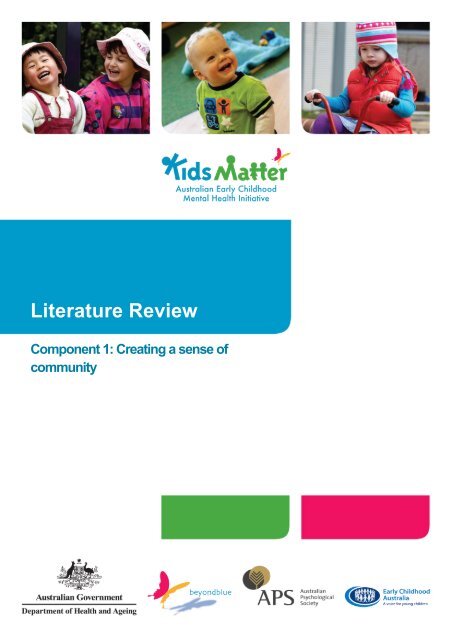
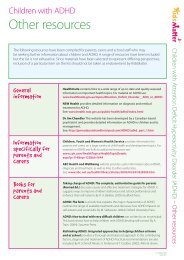
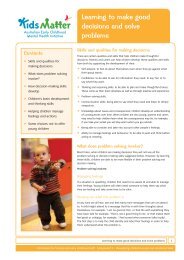
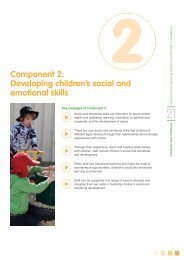
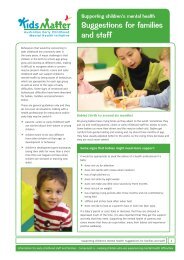
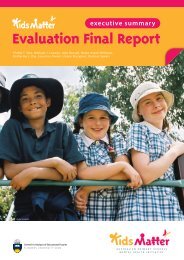

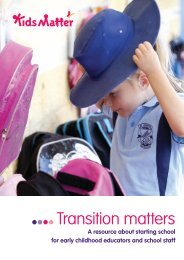
![Trinity Anglican School - Cairns story [378KB]pdf - KidsMatter](https://img.yumpu.com/41716076/1/184x260/trinity-anglican-school-cairns-story-378kbpdf-kidsmatter.jpg?quality=85)
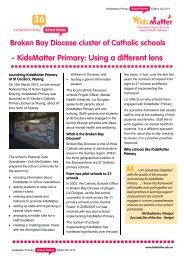
![Happy families work together [327KB] PDF - KidsMatter](https://img.yumpu.com/40767384/1/184x260/happy-families-work-together-327kb-pdf-kidsmatter.jpg?quality=85)
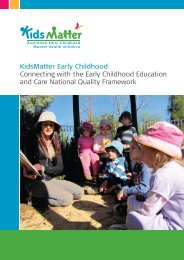
![Action Team Handbook 2012 [1.9M] [PDF] - KidsMatter](https://img.yumpu.com/38050920/1/184x260/action-team-handbook-2012-19m-pdf-kidsmatter.jpg?quality=85)
![[1008KB]pdf - KidsMatter](https://img.yumpu.com/38050895/1/184x260/1008kbpdf-kidsmatter.jpg?quality=85)
